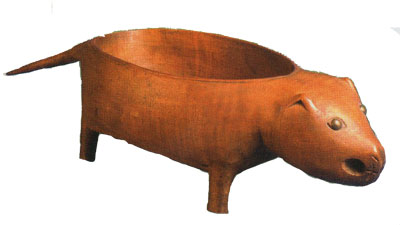
This wooden bowl was collected among the Kaskaskia (a sub-group of the Miami people) by George Turner, a judge in Illinois Territory in 1795. Collected along with three wooden pipestems and a catlinite pipe bowl, these are the oldest dated objects in the ethnographic collection of the American Section of the Museum. Turner collected two of these bowls in that year. One went to Charles Wilson Peale’s Museum which was housed in what is now Independence Hall. That bowl is currently in the collection of our sister institution, the Peabody Museum at Harvard. The second bowl went to the American Philosophical Society and through a series of transfers has ended up in our collection. Both bowls are carved in the shape of a beaver with the bowl opening in the back. Neither bowl exhibits any wear patterns which suggests that they were carved for Judge Turner if not on the spot, then at least just before he got there. They are, in fact, examples of early souvenir art, and demonstrate the rapidity with which Native Americans responded to a growing market and the desire for “exotic” material brought back from travels. This market continued to expand throughout the 19th century and into the 20th century.
